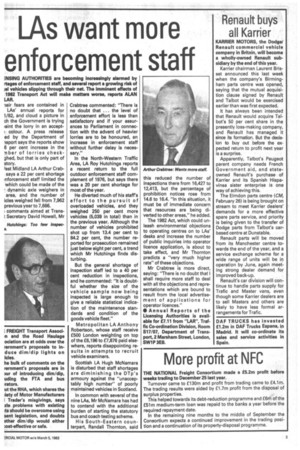LAs want m ore enforcement staff
Page 5

If you've noticed an error in this article please click here to report it so we can fix it.
iNSING AUTHORITIES are becoming increasingly alarmed by rtages of enforcement staff, and several report a growing risk of al vehicles slipping through their net. The imminent effects of 1982 Transport Act will make matters worse, reports ALAN LAR.
leir fears are contained in LAs' annual reports for 1/82, and cloud a picture in ch the Government is trying Paint the lorry in an accept colour. A press release ed by the Department of Isport says the reports show 6 per cent increase in the nber of lorries checkghed, but that is only part of story.
rest Midland LA Arthur Crabsays a 22 per cent shortage nforcement staff limited the which could be made of the • dynamic axle weighers in area, and the number of ides weighed fell from 7,962 previous year to 7,666.
comments aimed at TransSecretary David Howell, Mr Crabtree commented: "There is no doubt that the level of enforcement effort is less than satisfactory and if your assurances to Parliament in connection with the advent of heavier lorries are to be honoured, an increase in enforcement staff without further delay is necessary."
In the North-Western Traffic Area, LA Roy Hutchings reports a recent return to the full outdoor enforcement staff complement of 1976, but says there was a 20 per cent shortage for most of the year.
He diverted much of his staff's effort to the pursuit of overloaded vehicles, and they weighed 250 per cent more vehicles (5,039 in total) than in the previous year. Although the number of vehicles prohibited shot up from 13.4 per cent to 84.2 per cent, the number reported for prosecution remained just below eight per cent, a trend which Mr Hutchings finds disturbing.
But the general shortage of inspection staff led to a 40 per cent reduction in inspections, and he commented: "It is doubtful whether the size of the vehicle sample now being inspected is large enough to give a reliable statistical indication of the maintenence standards and condition of the goods vehicle fleet."
Metropolitan LA Anthony Robertson, whose staff receive £500 London weighting on top of the £6,196 to £7,876 paid elsewhere, reports disappointing results in attempts to recruit vehicle examiners.
Scottish LA Hugh McNamara is disturbed that staff shortages are diminishing the DTp's armoury against the "unacceptably high number" of poorly maintained vehicles in Scotland.
In common with several of the nine LAs, Mr McNamara has had to contend with the additional burden of starting the statutory bus and coach testing scheme.
His South-Eastern counterpart, Randall Thornton, said this reduced the number of inspections there from 16,427 to 12,413, but the percentage of prohibition notices rose from 14.6 to 16.4. "In this situation, it must be of immediate concern that resources are being diverted to other areas," he added.
The 1982 Act, which could unleash environmental objections to operating centres on to LAs' desks and increase the number of public inquiries into operator licence application, is about to take effect, and Mr Thornton predicts a "very much higher rate" of these objections.
Mr Crabtree is more direct, saying: "There is no doubt that I shall require more staff to deal with all the objections and representations which are bound to result from the local advertisement of applications for operator licences."
• Annual Reports of the Licensing Authorities is available for E7.11 from "LAW', Traffic Co-ordination Division, Room S17/07, Department of Transport, 2 Marsham Street, London, SW1P 3EB.












































































































